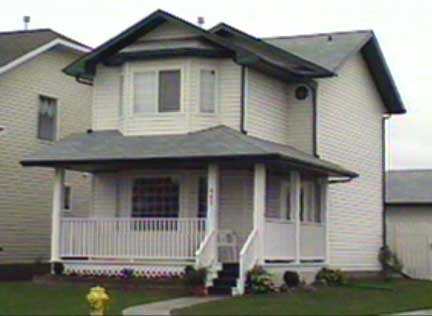 |
| FTLComm - Saskatoon - June 11, 2000 |
 This Saskatoon neighbourhood is remarkable as the brand new subdivision has a whole crescent of houses that appear to be mimicking the popular designs of the first world war or the early twenties. Verandahs, porches, bay windows, peeked roves and all two stories. These dull video pictures tell the story somewhat, they were taken Saturday morning during the rain and the subdued cloudy sky reduces the tone of the images but perhaps enhances the perspective on what this is |
 about. about. I suspect that some contractors and designers sensed a nostalgic sentiment among some home buyers and decided to produce a whole museum type of neighbourhood. Clearly the concept worked because all but a few of the homes have been purchased and as you can see folks have moved in and living in new old houses. The remarkable trend here is that these homes are efficient in terms of land space. In Regina and Saskatoon |
 neighbourhoods
with homes neighbourhoods
with homeslike these were built on fifty foot lots and like these do not have garages. This makes an efficient use of the space available and keeps down the price of the serviced lots. The absence of garages is an interesting one because houses of this original design were built in neighbourhoods served by public transit and in the twenties cars did not play such an important role in the life of a family. When you consider that today the family car cost almost as much as the dwelling you live in it is no wonder that most home owners set aside |
 a
major portion of their space a
major portion of their spaceto housing this major ongoing investment. These homes present an interesting curb view particularly since we are used to seeing this style of house built much closer together then these. Here in this Saskatoon neighbourhood these two story homes sit starkly apart from one another forming a neighbourhood that looks so remarkably different from any other. Verandahs are a neat thing, the modern deck that came along in the seventies harkens to the pleasant atmosphere of being able to go outside but the verandah has added dimensions to it with the provision of a roof and that |
 conversational
chatty environment conversational
chatty environmentthat we associate with another era. One of the things that we can see about these homes is that the designers and contractors were able to get a great variety of different appearances to add interest to the street and uniqueness to each dwelling despite their box like appearance from behind. Little round windows, classic doors, some have ginger bread decorations and in most lattice beneath the verandah floor. Features that have not been in home construction in seventy years. One of the positive things about houses of these designs is that they very effectively divide up the living space and tend to be |
 quiet but
this same feature quiet but
this same featureincreases the work load in keeping them neat and tidy as well as making for small rooms. It seems hard to imagine families going to "Walton" and "Leave It To Beaver" style housing with almost every family of today having to have both parents working just to cover the costs of affording a home and a car. Though I was unable to confirm this supposition it is likely that these houses are relatively inexpensive to produce and sell simply because of the small lots they require and their generally small land footprint. They have smaller roofs then conventional ranch style housing and should be efficient to heat and both pluming and electrical installation costs should be less because of the compact nature of the building. |
 If you want to check this neighbourhood out it is located in the extreme North West corner of Saskatoon with farm land to the North and West and within site of the city's airport, which is to the East of this location. One has to commend the developers for such a bold experiment and at the same time the new owners are likely to be an interesting lot as to why they chose to buy a new "old" house. The whole process might be well worth much more consideration and perhaps in the future I will get a chance to interview a home owner or two in the area and find out more about why and how this kind of house affects their lives and that of their neighbours. Timothy W. Shire |